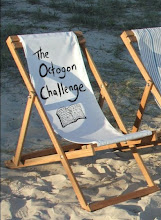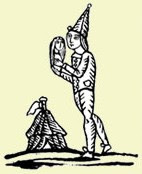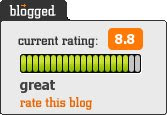You may remember my review of The Great Gatsby by F Scott Fitzgerald last year and so when this 1974 version of the film starring Robert Redford and Mia Farrow came on TV late one night I rushed to record it. I had not seen it before and the imagery for this famous adaptation had always convinced me, before reading the book, that the 'Great Gatsby' was a car. Now, of course, I know different, although the car is gorgeous, and very iconic of the age.
My memories of this novel are a colourful montage of images, opulent parties and lavish clothing, houses of the elite during the Jazz Age in America after the First World War. Fitzgerald's lovely descriptions, especially of the exotic party goers, are what stayed with me, as well as the huge set pieces that were begging to be translated into a film.
I was not disappointed. This film pulls out all the stops to accurately reproduce each scene with care and attention to detail. Costumes of the Long Island rich are extravagant and ridiculously impractical, make up and hair flawless. Everything reeks of money.
The casting works brilliantly too. I was aware of Redford as Gatsby already, so his presence may have infiltrated my reading of the book anyway, but Mia Farrow, Bruce Dern and Sam Waterstone are excellent in their roles also.
The narrative slides by, quietly and with sophistication, as does the book. The party scene mid way through is a spectacle in itself with wild Charlston type dancing and millions of extras.
My only criticism was that it was a little long and I was quite tired by the end. I would imagine that for anyone who has not read this brilliant novel it may be a bit of a slog and not fully hold your interest. I don't know. I enjoyed it because I enjoyed the book and this enhanced the former experience by faithfully reproducing the mood, era and images to a screen. There were scenes in this movie, the petrol garage particularly, that were almost exactly as I had imagined them. If I did not have that foundation to build on I might have found it a bit dull and drawn out. I know that it has mixed reviews, but it cannot be criticised for any lack of glamour, or effort, or loyalty. It is pace that lets it down, but it is also this that recreates, in my opinion, the heady mood of the original novel.
In conclusion, this movie may be best watched after experiencing the book, as a faithful revisitation of a hugely loved story, one that many, and not just Americans, have grown up with. I would love to think that it would inspire a non-reader to read the novel, and very possibly it has, but I wonder if for others it may be considered long-winded and they find their attention waning half way through.
I enjoyed visually revisiting this classic novel that I enjoyed last year, I do love Robert Redford too, and I am very much looking forward to the new version later this year with Leonardo di Caprio, Carey Mulligan and Tobey Maguire.
This post completes #5 of my personal challenges during 2012 to compare 3 books to their movie counterparts, the previous ones being North and South by Elizabeth Gaskell and We Need To Talk About Kevin by Lionel Shriver.
Quote
The true university these days is a collection of books.
-Thomas Carlyle
-Thomas Carlyle
Friday, 22 June 2012
Wednesday, 13 June 2012
Dubliners by James Joyce
Dubliners was my first James Joyce book and part of the challenge from my work colleague AR, to read at least one of 3 titles chosen for me, by the end of the year.
Joyce wrote this book, his first, in 1914. It is a collection of short stories about various characters in Dublin around the turn of the century. Some of the characters stories overlap but each piece is a stand alone story. Most of the stories are quite short, 10 to 20 pages on average, covering small instances within the lives of a mixed set of people, young, old, men, women, groups or alone, all of them working class in Dublin.
In viewing these snapshots of their lives we are able to glimpse the wider community and interactions. From a young boys reaction to the family priests death in The Sisters, to an alcoholic about to lose his job and spending his last pennies on ale, to go home and take it all out on his children in Counterparts. There is also a group of men talking before a commitee meeting in Ivy Day in the Commitee Room, to a mother standing up for her musician daughter at a local concert in A Mother. None of the characters are well off, and some have varying fortune in their lives, but interaction, of friends and family, good and bad, features prominently in each chapter. The last story, The Dead, is much longer and feels like a short novella. It covers an entire evenings gathering and the subsequent hours afterward, and mentions a few of the characters from previous stories, bringing it all together. I have only picked out some of the tales, there are 15 in all.
The writing is beautiful throughout and each story has the feeling of joining an everyday incident half way through and leaves before it is ended. You sense that a lot has happened before and after the point where you come in, so each one is like a living thing. Some of the stories recount something that happens, others detail the ordinariness of life.
The cover picture of this edition is very evocative of the age in which these stories are set and was something that I found easy to connect with coming from, and growing up in Toxteth in Liverpool. Even during the 1970's there were parts of my childhood neighbourhood that enabled me to understand the setting and people that Joyce depicts here, as well as the history of my city and its own Irish connections and working class streets. The simple but skillful language used makes this book a joy to read. I loved the economy of the events pitched alongside the richness of the words. The subjects that pass through this book are very real and admirable for being written down.
This set of stories are a real treat for literature fans and those who like classic writing of the early 20th century with the late 1800's as an influential backdrop. Poverty and struggle play side by side with humanity and community. Highly recommended, and I know that I will pick this book up in the future and revisit the stories in it, for pure pleasure.
For a Penguin Reading Guide to Dubliners use the link.
For more information about classic Irish writer James Joyce use the link.
Joyce wrote this book, his first, in 1914. It is a collection of short stories about various characters in Dublin around the turn of the century. Some of the characters stories overlap but each piece is a stand alone story. Most of the stories are quite short, 10 to 20 pages on average, covering small instances within the lives of a mixed set of people, young, old, men, women, groups or alone, all of them working class in Dublin.
In viewing these snapshots of their lives we are able to glimpse the wider community and interactions. From a young boys reaction to the family priests death in The Sisters, to an alcoholic about to lose his job and spending his last pennies on ale, to go home and take it all out on his children in Counterparts. There is also a group of men talking before a commitee meeting in Ivy Day in the Commitee Room, to a mother standing up for her musician daughter at a local concert in A Mother. None of the characters are well off, and some have varying fortune in their lives, but interaction, of friends and family, good and bad, features prominently in each chapter. The last story, The Dead, is much longer and feels like a short novella. It covers an entire evenings gathering and the subsequent hours afterward, and mentions a few of the characters from previous stories, bringing it all together. I have only picked out some of the tales, there are 15 in all.
The writing is beautiful throughout and each story has the feeling of joining an everyday incident half way through and leaves before it is ended. You sense that a lot has happened before and after the point where you come in, so each one is like a living thing. Some of the stories recount something that happens, others detail the ordinariness of life.
The cover picture of this edition is very evocative of the age in which these stories are set and was something that I found easy to connect with coming from, and growing up in Toxteth in Liverpool. Even during the 1970's there were parts of my childhood neighbourhood that enabled me to understand the setting and people that Joyce depicts here, as well as the history of my city and its own Irish connections and working class streets. The simple but skillful language used makes this book a joy to read. I loved the economy of the events pitched alongside the richness of the words. The subjects that pass through this book are very real and admirable for being written down.
This set of stories are a real treat for literature fans and those who like classic writing of the early 20th century with the late 1800's as an influential backdrop. Poverty and struggle play side by side with humanity and community. Highly recommended, and I know that I will pick this book up in the future and revisit the stories in it, for pure pleasure.
For a Penguin Reading Guide to Dubliners use the link.
For more information about classic Irish writer James Joyce use the link.
Friday, 1 June 2012
May Roundup
Summer is here, warm weather, blue skies (mainly). There is nothing I love more than finding a shady bit of grass, near a tree, and taking a book to read. Indulgent I know, when time is precious, but an essential luxury, however sparsley captured, to those of us who love to read books.
How did we do in May...
Read - 2 and a half books
Completed -
The Summer Book by Tove Jansson
The Bookseller of Kabul by Asne Seierstad
Currently Reading -
The Lost and Forgotten Languages of Shanghai by Ruiyan Xu
Notes from Walnut Tree Farm by Roger Deakin
The Organic Year by Patricia Gallilmore
TBR Pile - Currently groaning at 123 books (according to GoodReads) with quite a few added this month...
Written Lives by Javier Marias
Bad Dirt by Annie Proulx
The Wasp Factory by Iain Banks
The Tortilla Curtain by t. coraghessan boyle
Beyond Black by Hilary Mantel
The Distant Hours by Kate Morton
The Understudy by David Nicholls
Norwegian Wood by Haruki Murakami
Challenges -
Despite the many additions to my TBR pile in May, I have still kept to #1 of my own challenges to not buy any new books this year. Written Lives was a secondhand copy from Oxfam, and the rest were from our Book Swap in work.
Completed #3 of my challenges to read at least 2 titles that came up during our Novel holidays by completing The Summer Book by Tove Jansson (which was brought up as a recommendation by RB on our Jane Austen Holiday in Hampshire) and completing The Bookseller of Kabul by Asne Seierstad (which was my lucky dip title from CS on our Thomas Hardy Holiday in Dorset). Reviews are on their way here soon.
Wishlist Additions -
Home by Toni Morrison
This Is How: Proven Aid in Overcoming... by Augusten Burroughs
The Perks Of Being A Wallflower by Stephen Chbosky
The Devil's Beat by Robert Edric
Afterward: A Novel by Rosamund Lupton
The History of the Countryside by Oliver Racknam
Discoveries -
I am now on Twitter, and getting more than a little addicted. Decided to see what it was all about and have discovered a whole new world. I may see you there too...(link is on my sidebar by 'About me')
Events -
Had our BookSwap in work, now an annual event due to its popularity, and a great way to recycle and get people talking about books. I started off with 4 books, but there were 3 more at the end that were going to Oxfam so I adopted those too. See above for the brilliant titles, and I think lots of other people got some good ones too. It was a great success.
The Norman Conquests (a trilogy of plays by Alan Ayckbourn) are on at the Liverpool Playhouse and well worth a watch. I have seen 2 so far (Living Room and Round and Round the Garden). Great plays for the summer, a bit of 70's comic nostalgia, and some Norman mayhem in true Ayckbourn style.
I am off on my annual trip to work on the beautiful farm in Devon for a week...will see you when I get back.
How did we do in May...
Read - 2 and a half books
Completed -
The Summer Book by Tove Jansson
The Bookseller of Kabul by Asne Seierstad
Currently Reading -
The Lost and Forgotten Languages of Shanghai by Ruiyan Xu
Notes from Walnut Tree Farm by Roger Deakin
The Organic Year by Patricia Gallilmore
TBR Pile - Currently groaning at 123 books (according to GoodReads) with quite a few added this month...
Written Lives by Javier Marias
Bad Dirt by Annie Proulx
The Wasp Factory by Iain Banks
The Tortilla Curtain by t. coraghessan boyle
Beyond Black by Hilary Mantel
The Distant Hours by Kate Morton
The Understudy by David Nicholls
Norwegian Wood by Haruki Murakami
Challenges -
Despite the many additions to my TBR pile in May, I have still kept to #1 of my own challenges to not buy any new books this year. Written Lives was a secondhand copy from Oxfam, and the rest were from our Book Swap in work.
Completed #3 of my challenges to read at least 2 titles that came up during our Novel holidays by completing The Summer Book by Tove Jansson (which was brought up as a recommendation by RB on our Jane Austen Holiday in Hampshire) and completing The Bookseller of Kabul by Asne Seierstad (which was my lucky dip title from CS on our Thomas Hardy Holiday in Dorset). Reviews are on their way here soon.
Wishlist Additions -
Home by Toni Morrison
This Is How: Proven Aid in Overcoming... by Augusten Burroughs
The Perks Of Being A Wallflower by Stephen Chbosky
The Devil's Beat by Robert Edric
Afterward: A Novel by Rosamund Lupton
The History of the Countryside by Oliver Racknam
Discoveries -
I am now on Twitter, and getting more than a little addicted. Decided to see what it was all about and have discovered a whole new world. I may see you there too...(link is on my sidebar by 'About me')
Events -
Had our BookSwap in work, now an annual event due to its popularity, and a great way to recycle and get people talking about books. I started off with 4 books, but there were 3 more at the end that were going to Oxfam so I adopted those too. See above for the brilliant titles, and I think lots of other people got some good ones too. It was a great success.
The Norman Conquests (a trilogy of plays by Alan Ayckbourn) are on at the Liverpool Playhouse and well worth a watch. I have seen 2 so far (Living Room and Round and Round the Garden). Great plays for the summer, a bit of 70's comic nostalgia, and some Norman mayhem in true Ayckbourn style.
I am off on my annual trip to work on the beautiful farm in Devon for a week...will see you when I get back.
Subscribe to:
Comments (Atom)
Hay on Wye


























